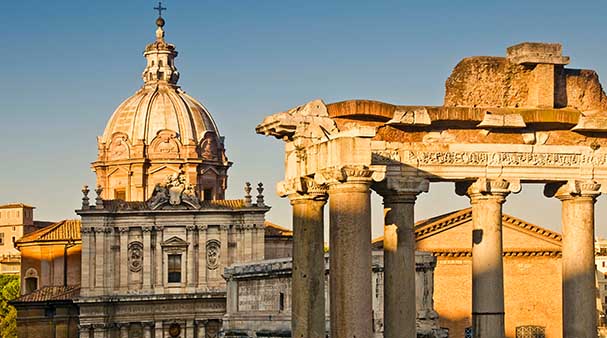 Byzantine: From the 6th century, it’s medium was mainly in mosaics, the application of which suited ‘emphatic, transcendent mysticism’, typical of religious representations. Stylistically it shows austerity in design and is two-dimensional.
Byzantine: From the 6th century, it’s medium was mainly in mosaics, the application of which suited ‘emphatic, transcendent mysticism’, typical of religious representations. Stylistically it shows austerity in design and is two-dimensional.
It began with Constantine the Great when he rebuilt the city of Byzantium and named it Constantinople and continued with his building of churches and the forum of Constantine.
Its architecture dramatically influenced the later medieval architecture throughout Europe and the Near East, and became the primary progenitor of the Renaissance and Ottoman architectural traditions that followed its collapse.
 Romanesque: From late 11th to early 13th centuries. Has its basis in provincial, folk-like simplicity. Characterised by a squat, round form of architecture.
Romanesque: From late 11th to early 13th centuries. Has its basis in provincial, folk-like simplicity. Characterised by a squat, round form of architecture.
Combining features of ancient Roman and Byzantine buildings and other local traditions, Romanesque architecture is known by its massive quality, thick walls, round arches, sturdy pillars, barrel vaults, large towers and decorative arcading. Each building has clearly defined forms, frequently of very regular, symmetrical plan; the overall appearance is one of simplicity when compared with the Gothic buildings that were to follow. The style can be identified right across Europe, despite regional characteristics and different materials.
 Gothic: Characterised by verticality and lightness, achieved with the use of buttresses, cross vaults and pointed arches. Mostly 13th and 14th century.
Gothic: Characterised by verticality and lightness, achieved with the use of buttresses, cross vaults and pointed arches. Mostly 13th and 14th century.
Italian architects, rather than their French counterparts, preferred to keep the construction tradition established in the previous centuries. Aesthetically, in Italy the vertical development was rarely important.
 Renaissance: Movement began in late 14th century and culminated in 16th century with the High Renaissance.
Renaissance: Movement began in late 14th century and culminated in 16th century with the High Renaissance.
It signifies the ‘rebirth’ of the interest in classical learning, art and architecture.
It was a period characterised by innovation, imagination and creativity.
 Baroque: Originally meaning ‘capricious’ or ‘irregular’, at the end of the 16th century it became synonymous with the ornate flourishes both in architecture and art that came after the simple classical straightforwardness of the Renaissance. As it grew it became freer and more exuberant, lasting until the middle of the 18th century when austerity became the norm.
Baroque: Originally meaning ‘capricious’ or ‘irregular’, at the end of the 16th century it became synonymous with the ornate flourishes both in architecture and art that came after the simple classical straightforwardness of the Renaissance. As it grew it became freer and more exuberant, lasting until the middle of the 18th century when austerity became the norm.
 Rococo: Followed the excesses of Baroque in the mid 18th century, based on gracefulness, elegance and fanciful curves.
Rococo: Followed the excesses of Baroque in the mid 18th century, based on gracefulness, elegance and fanciful curves.
 Neoclassicism: Mid 18th century to mid 19th century revival of the virtues of Greek and Roman classical art. Mirrored the period of the Enlightenment, based on reason and the ancient values.
Neoclassicism: Mid 18th century to mid 19th century revival of the virtues of Greek and Roman classical art. Mirrored the period of the Enlightenment, based on reason and the ancient values.
 Romanticism: From the late 18th century, its form was a contrast to the rational formality of Neoclassicism, allowing spontaneous and emotional design to take over. At the same time it was meant to embody the Christian values of humanity and passion.
Romanticism: From the late 18th century, its form was a contrast to the rational formality of Neoclassicism, allowing spontaneous and emotional design to take over. At the same time it was meant to embody the Christian values of humanity and passion.


